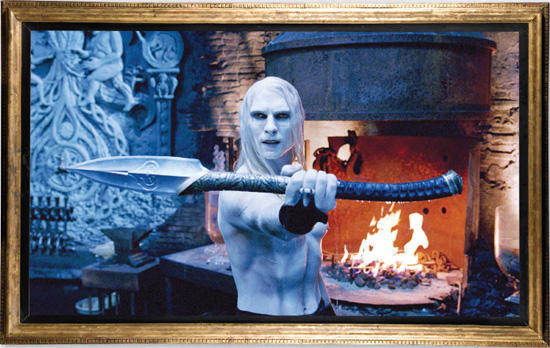THE BACKYARD
The backyard shared by the two wings of Bleak House is surprisingly sunny and pleasant, and Guillermo admits he doesn’t work here. “I don’t like the outside. But I like sitting here in the shade, just enjoying the silence.”
In truth, Guillermo wishes he had gnarled trees like those his neighbors down the block have planted. A bit of Victorian topiary would lend a more somber mood to Bleak House’s yard and complement the rest of the decor.
But that’s a dream to be realized another day. For now, the backyard is a serene place where Guillermo can contemplate his next projects in the company of a life-size bronze sculpture of Ray Harryhausen, one of his creative patron saints.
One final question remains: Was this exactly the house he wanted when he was a kid?
“Yes,” Guillermo affirms, “if I ever finish….”
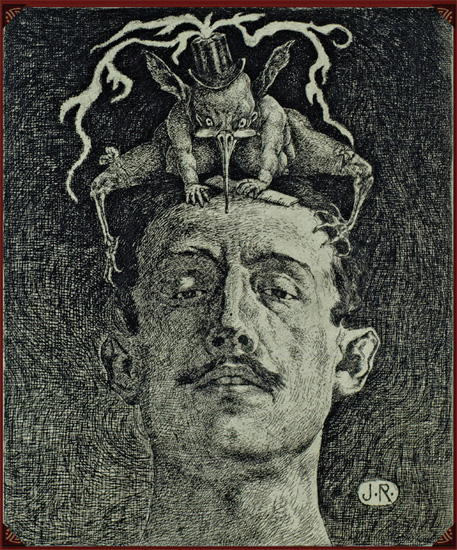
Julio Ruelas’s The Critics (1906), a print of which hangs in the entryway at Bleak House.
GRAPHIC INSPIRATIONS
MSZ: Your work involves such a melding of influences. Is there a specific fine artist that you might say is your favorite?
GDT: Well, the guy I connect with most viscerally is Francisco Goya because I just find him incredibly powerful.
But I love the symbolists and I love some of the surrealists. Of the symbolists, I love Marcel Schwob, Félicien Rops, Odilon Redon. I was very influenced by Rops. And I love Mexican symbolist artists. I have two original drawings at Bleak House by an artist named Julio Ruelas. He did one of my favorite engravings. I have it right in the entrance. It’s called The Critics, and it is a self-portrait where Ruelas has a parasite with a long beak and a top hat on his head.
Ruelas was really incredible. He was influenced by Arnold Böcklin, who is another favorite of mine, but he was also influenced by Félicien Rops. Ruelas is very lewd, but he’s also very sensual and sort of a necrophiliac. He is a very strange guy. One of his drawings that influenced everything I do is called Profane Pieta, and it’s a crucifixion with the virgin at the foot of the cross. It looks like a really great religious illustration. You can show it to your grandmother, and she’ll go, “Oh, what a beautiful religious painting.”
But then, if you observe carefully, Christ has an erection—the shadow of death has taken him over—and the virgin has one breast out and a snake is suckling or biting her. I learned from this painting that you can make things with one apparent surface meaning and have them work as a symbolist piece that is completely counter, depending on the way you organize the symbols. I was fascinated by that drawing. I discovered it when I was sixteen or seventeen, and it had a big impact on me.
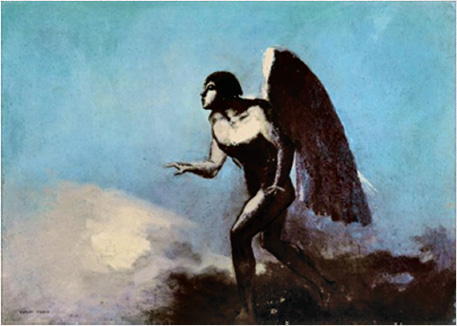
A sketch of Odilon Redon’s feathered eye motif in one of del Toro’s early notebooks.
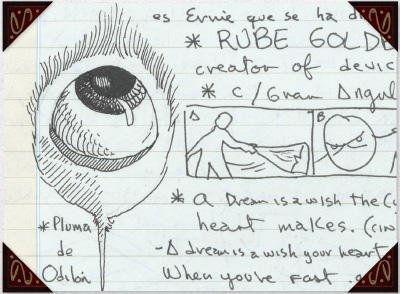
The Winged Man (1880), by Redon, a classic symbolist image that has inspired del Toro.
After that, I started to really get into the methodology of how to read a painting, and I started to appreciate the little symbols that medieval and Renaissance portraits would use, the symbology in Gothic cathedrals. And then I got into alchemy. My mind has always been guided by curiosity.
MSZ: With respect to the symbolists, you really can see resonances from those guys, such as Redon and Rops, in a lot of the visual elements that you explore.
GDT: Yeah, Redon and his feathered eyes. Fantastic. Proto-symbolist, actually.
MSZ: He’s an interesting bridge between the symbolists and the Pre-Raphaelites just in terms of his style.
GDT: I’m also fascinated by the lives of the Pre-Raphaelites and their ideas. They certainly are very interesting characters that start with the same spirit and, as you read about their lives, they get co-opted by the society that they set out to overturn. It’s a very interesting artistic moment.
MSZ: Why, then, do the symbolists have more power than the Pre-Raphaelites for you?
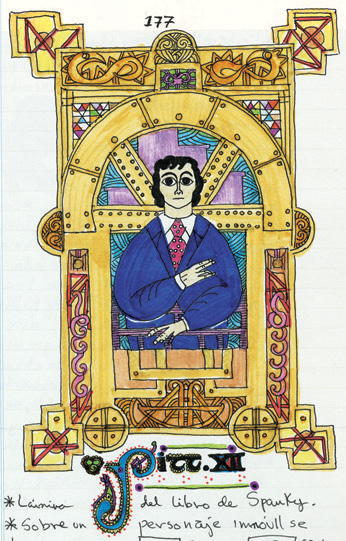
An illustration for Mephisto’s Bridge, one of del Toro’s unrealized projects, done in the style of a medieval illustration.
GDT: To me, the Pre-Raphaelites are more surface driven. More superficial. Vanity and aesthetics eventually overpower their spirituality and otherworldly power. The symbolists, on the other hand, tried to organize stuff, like medieval painters did—where they would organize every detail in a painting to tell a story. Like a portrait of a young woman—she would be holding a peach, which would represent the ephemeral nature of beauty. Because the peach rots very fast. Then, by the same token, there would be flowers. And there would be a skull. They would organize things so you would read the painting. But the symbolists take all that much further. And they start bringing in elements of subterranean eroticism, buried, unconscious desires. In some ways, they prefigure Dada and Surrealism in that they tap into concepts and ideas and spirituality but are driven by impulse!
MSZ: I see them as an arrow right into your work because your work puts beauty and sensitivity right alongside grotesquerie and death. You don’t sugarcoat stuff.
GDT: That’s what surprises me a lot when I read reviews of my work. I read one criticism on Pan’s Labyrinth in which somebody said, “Well, it’s a very simple dichotomy. Fantasy is beautiful, real life is hard.” And I thought, What movie did they watch? The fantasy in Pan’s Labyrinth, except for the ending, is super grimy. The fairies are these little imps that are dirty, naked, and kind of evil looking. The Faun is incredibly ambivalent, even menacing. I cannot think of the frog as a pleasant piece of fantasy. Or, much less so, the Pale Man. And having to feed the mandrake with blood, and the fetal implications of the mandrake? I mean, I tried to make the fantasy as gritty as reality because that’s what it’s supposed to be.
When you seek beauty only within a world of perfection, you end up with illustrations of fairies dressed in pink tutus, sprinkling dust, with cherubic babies and a flower garden. And then the images really, in my mind, don’t have any weight, any gravity. But when you have seen something horrible and you choose to create something beautiful, the work comes out with a hefty weight, and I think that’s why I like Rops, who was undoubtedly a guy who was tragic and fascinated by war, tragedy, destruction, and sex. He creates something beautiful out of that.
MSZ: The feeling with Rops is that he really indulged in a lot of vices.
GDT: Such was the life of the bohemians and the life of the symbolists. They would explore pleasure no matter what the consequences. After a certain moment in the history of art, the artist and the work become indivisible. For example, you can see the essence of Van Gogh in his paintings.
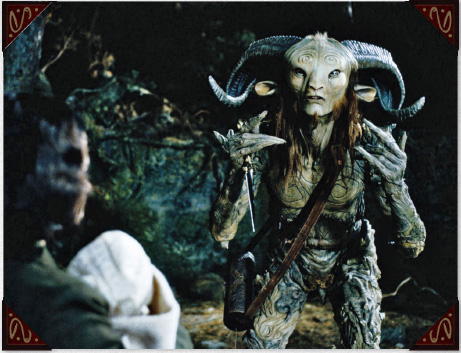
The Faun (Doug Jones) in Pan’s Labyrinth is intentionally both inviting and menacing.
